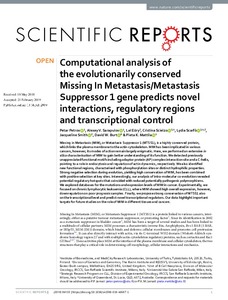Computational analysis of the evolutionarily conserved Missing In Metastasis/Metastasis Suppressor 1 gene predicts novel interactions, regulatory regions and transcriptional control
Petar Petrov; Alexey V. Sarapulov; Lel Eöry; Cristina Scielzo; Lydia Scarfò; Jacqueline Smith; David W. Burt; Pieta K. Mattila
Computational analysis of the evolutionarily conserved Missing In Metastasis/Metastasis Suppressor 1 gene predicts novel interactions, regulatory regions and transcriptional control
Petar Petrov
Alexey V. Sarapulov
Lel Eöry
Cristina Scielzo
Lydia Scarfò
Jacqueline Smith
David W. Burt
Pieta K. Mattila
NATURE PUBLISHING GROUP
Julkaisun pysyvä osoite on:
https://urn.fi/URN:NBN:fi-fe2021042826534
https://urn.fi/URN:NBN:fi-fe2021042826534
Tiivistelmä
Missing in Metastasis (MIM), or Metastasis Suppressor 1 (MTSS1), is a highly conserved protein, which links the plasma membrane to the actin cytoskeleton. MIM has been implicated in various cancers, however, its modes of action remain largely enigmatic. Here, we performed an extensive in silico characterisation of MIM to gain better understanding of its function. We detected previously unappreciated functional motifs including adaptor protein (AP) complex interaction site and a C-helix, pointing to a role in endocytosis and regulation of actin dynamics, respectively. We also identified new functional regions, characterised with phosphorylation sites or distinct hydrophilic properties. Strong negative selection during evolution, yielding high conservation of MIM, has been combined with positive selection at key sites. Interestingly, our analysis of intra-molecular co-evolution revealed potential regulatory hotspots that coincided with reduced potentially pathogenic polymorphisms. We explored databases for the mutations and expression levels of MIM in cancer. Experimentally, we focused on chronic lymphocytic leukaemia (CLL), where MIM showed high overall expression, however, downregulation on poor prognosis samples. Finally, we propose strong conservation of MTSS1 also on the transcriptional level and predict novel transcriptional regulators. Our data highlight important targets for future studies on the role of MIM in different tissues and cancers.
Kokoelmat
- Rinnakkaistallenteet [27094]
